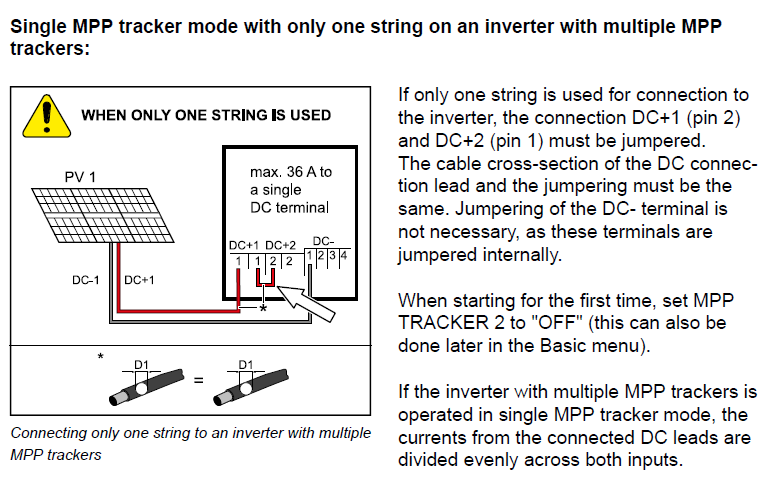So far my reading up haven’t really touched AC coupled PV inverters like the Fronius Primo 3.6-1 and I also haven’t really seen a lot of posts / installs with it. It is starting to look attractive to me, so I am trying to wrap my head around it and thought I’d start by asking for some assistance here as Fronius now has me confused.
My idea is to have a 5kVA Multi along with the AC coupled 3.6kW Primo.
Looking at the technical data for the Primo it shows that the MPP voltage range is 200 - 800 V which is obviously where you would like to be to get the most out of your PV panels.
The inverter has 2x MPP trackers. I first assumed that the 200 - 800 V meant the total voltage across the 2x MPPT’s and not per MPPT. I’ve since started thinking that it means per MPPT because in their ‘recommended’ configuration it seems to be 1 string and ‘jumpering’ the 2x MPPT’s which seems to be the easiest way of getting to the 200V earlier. Does anyone know for sure?
In my specific case I will have East and West facing PV, so I would ideally want to have 1 string on the Eastern roof going to the one MPPT and another string on the Western roof going to the other MPPT.
Fronius has a nice Solar.Configurator tool which is quite handy. It has the JA Solar 345W (JAM60S10-345.MR) panels which I’m not specifically looking at, but the Volt & Amp differences are negligible between models. It shows that you can wire them all up on 1 string (the installation manual shows that you connect them all to MPPT 1 and then add a jumper to MPPT 2 and switch off MPPT 2 in the configuration), or you can (with 10 panels) do a 7/3 split between the 2x MPPTs. The options are 1x10, 1x7+1x3, 1x6+1x4, 2x5 (one MPPT), and 1x5+1x5. That seems to be an order of preference as well.
My guess would be that the 3 panels in a 7/3 split won’t reach the maximum power point as they’ll do ~105 V at 25C, but the 7 panels will be operating at MPP as they’ll do ~245 V at 25C and ~200 V at 85C. But the smaller string will at least start feeding as the inverter starts at 80 V.
How big will the difference be when operating at MPP versus not? I’m just trying to figure out how big of a difference it will make and if it won’t be better to just move it all to 1 side and have it all on 1 string running at their MPP.
Although while typing this I realized that I’m just overcomplicating it. I also though about adding a couple of panels on a DC coupled MPPT to help charging more efficiently and also add to the loads, but I though about first seeing how it does using just the AC from the Primo as there should be enough capacity once the geyser is done to still charge up the batteries even if it is less efficient.
I might as well just add a couple of panels and a DC coupled MPPT from the start to the East which can help out with early morning loads and some charging and then have 10 panels on the West on the Primo and schedule the loads to only start when the Primo starts generating after which the DC MPPT can charge the batteries along with what’s left over from the Primo via the Multi.
